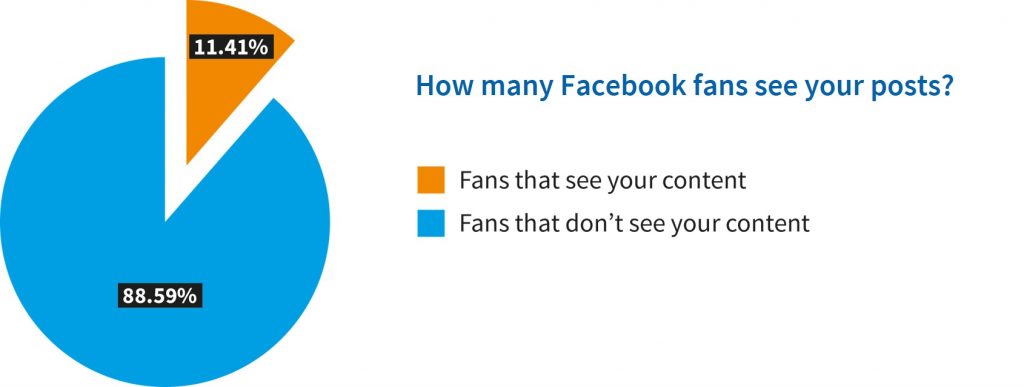A New Definition of Edgerank
Facebook Pages are not what they used to be.
It may (or may not) come as a surprise to discover that only a tiny proportion of the content published by Pages that you “Like” actually reaches your News Feed. Some studies put this percentage (known as “reach”) at as little as 2%. Even the most optimistic of studies suggest that little over 11% of a Page’s fans will see its content.

This is due to the existence of a filtering mechanism Facebook uses that employs a complex algorithm. Without the algorithm in place you’d be overwhelmed with something like 1,500 posts a day on your News Feed. And a lot of those would be from brand Pages.
Facebook is well aware that users like to see content from friends and family first, and dislike a News Feed cluttered with promotional messages from brands. So it limits them.
But what criteria does it use and how can brand Pages crack this algorithm to ensure that they get the maximum visibility possible for their posts?
I’ve spent years studying the algorithm (it’s known in some circles as EdgeRank but that’s not a term Facebook itself uses any more). I’ve taught on it and conducted multiple experiments in an attempt to figure out what works and what doesn’t.
I’ve read hundreds of articles, looked at myriad studies and scoured Facebook’s own statements to better understand the 100,000+ factors it uses when deciding which content to show which user.
That research has led me to redefine the traditional way in which the algorithm is explained. I’ve devised the following to summarise those 100,000 factors:

Let’s examine each of those elements:
- News Feed Visibility (often described “EdgeRank”) – this is based on a score of how relevant Facebook considers the content (known as a “story”) to be and takes into account an immense number of factors.
A story can be a status update, photo, video, comment, like, tag, event, relationship status change or any of the other pieces of content that you see in News Feed. - Interest – this is concerned with how interested you are in the creator of the story. Is it a best friend you engage with all the time on Facebook, a mere acquaintance you barely interact with, a brand you love and share content from regularly or a brand you’ve lost interest in and ignored in recent times. Interest is also gauged by how long you spent in the past on stories that person/Page has posted, how you reacted to those stories (clicked, liked, commented, shared etc).
- Post Performance – this considers how well this story is performing with other users and the kind of reactions is it getting. If your friends have liked the post you are more likely to see it pop into your own News Feed.
- Past Page Performance – is the Page verified? What type of Page is it? Does it have complete profile information? How old is the Page? How many fans does it have? How engaged are those fans with the Page and its recent content? Have your fans elected to see your content first?
On the other hand, it may not even be a Page, posts from Facebook Groups enjoy a lot more visibility due to a different algorithm at work. - Type of content – there are two overarching factors at play here. Facebook itself weights some types of post more highly than others (right now it prefers natively uploaded Facebook video above anything else). It also factors in the type of content a user prefers – do they look at lots of photos on Facebook, click a lot of links, watch videos regularly?
So some content types are given a higher score and promoted, and less popular types of content will get a lower reach and either sit lower in the news feed or barely be shown at all.
Then the content itself will be hugely influential. Does it tag other Pages? Does it use any of Facebook’s negative trigger words that will see instant throttling? Will Facebook deem the post to be spammy or promotional and therefore squash its reach? Does the headline indicate clickbait? Is the image used new to Facebook or is it a stock photo that’s been seen a million times before? If it’s a link how many other users have shared it already? What’s the quality of the landing page the link leads to? - Recency – this is to do with the age of a post. Generally, the longer a story has been live the less likely it is to be seen. There will be exceptions: with personal posts, announcements of, for example, engagements, tend to stick around News Feed for longer. And for Page posts, “Story Bumping” kicks in when an older story suddenly starts to get a lot of interactions.
Recency also raises the question of when the best time is to post. When are your fans on Facebook? How busy is the timeline with other content when you are posting?
Understanding the basic underpinning principles of the algorithm is the first step on a journey to better performing content for brand Pages. Content that gets visibility without having to pay to promote it.
I’ve written up my research in the form of a book (you can find it on Amazon or on the Digiterati Academy website) and also in an online course one of many in our recently launched Digiterati Academy. They are packed full of examples of brands that get it right and a few clangers from brands getting it very wrong. I’ve also gone into great detail about each of the above factors and what you can do to master each of them.
source http://www.smartinsights.com/social-media-marketing/facebook-marketing/cracking-facebooks-news-feed-algorithm-new-definition-edgerank/

No comments:
Post a Comment